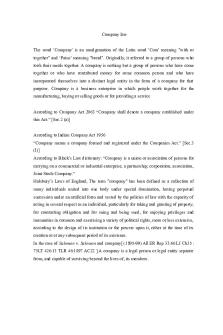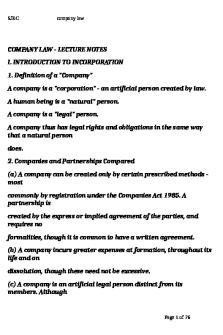Company Law Essay PLAN PDF

| Title | Company Law Essay PLAN |
|---|---|
| Course | COMPANY LAW |
| Institution | University of Aberdeen |
| Pages | 4 |
| File Size | 116.1 KB |
| File Type | |
| Total Downloads | 40 |
| Total Views | 189 |
Summary
Essay Plan...
Description
A.Wi t hr ef er encet opr i mar ysour cesandr el evantcor por at el egalt heor y,cr i t i cal l yanal yse t heext entt owhi cht heCompani esAct2006al t er edt hel aw’ spol i cyor i ent at i oni nr espect oft hebenefici ar i esofdi r ect or s’dut i es.
INTRODUCTION - Outline topic o Companies can be governed in many different ways. The nature of their relationships can range from contractual nature to constitutional. - Road map o Firstly, it is important to look at different theories of company law o Then, look at the common law position and why changes were brought about o Then see what changes were made and if this was beneficial - Thesis – companies act did not do much change, just created a middle ground THEORIES OF CONTRACTUAL LAW - Many ways in which a company can be organised - Contractual – often known as a “nexus of contracts” meaning they can organise their relations as they wish.1 o Two types, legal and economic Legal “Entity remote from regulatory interference”2 o Only recognised by the state as a “nexus of contracts” that parties to are allowed to structure their relationship however they wish.3 o Means it falls under private law State still plays a significant role o Eley v Positive Government Life Assurance o Courts still apply public law for proper interpretation Economic economic contractualists proceed on the assumption that economically rational decisions by individuals will also benefit society
-
-
Concession o Another theory is In this, companies rely on the state for structure Gives them a constitution to work with CA brought a middle ground between the two
COMMON LAW POSITION
1 Contractual theory p100 2 Dine article 3 The contractual theory of the corporation
-
-
-
-
-
-
-
Start by outlining common law to the point where interest of company was shareholder interest o Dawson International Plc v Coats Poaton Plc If directors advise shareholders, have to advise in good faith But argued that this is not as a result of a duty towards shareholders, but rather a liability resulting from their actions out of ordinary principles of law. 4 But they still have one master – the company o Peskin v Anderson Former members of a company sued directors for breach of duty claiming they should have been informed of negotiations to sell one of the businesses that the company owned Held that no duty was owed as there was no contact or special relationship between them Shows again that directors duties are owed to the company o Some say this is known as shareholder primary principle.5 As the directors priority is the interest of shareholders over other stakeholders in the company. o Only consider other stakeholders such as creditors in situations of insolvency Charterbridge Corp Ltd v Lloyds Bank Ltd o objective test when determining good faith Boulting v Association of Cinematograph, Television and Allied Technicians o Duty to act in best interests of the company o Cannot enter into contract that binds them into disregarding their duties – has to stay independent Fulham football club v Cabra Estates plc o Duty to act in best interests of the company – old s173 o Directors entered contract allowing future development of the grounds by owners o Tried to get out on grounds that not in interest of club – but it was beneficial contract o Held cannot get out Item Software (UK) Ltd v Fassihi o Duty of loyalty o A director failed to disclose own misconduct so was in breach of his duty of loyalty as because tried to divert the company’s business to another established for his own purposes. Mutual Life Insurance Co of New York v Rank Organization Ltd o Duty to act fairly
Talk about general election environment where why the legislation had to occur
4 Kewshaw textbook 5 Considering the enlightened shareholder value principle
o 1997 labour elected – new labour o Wanted a move from shareholder interest to enlightened shareholder value principle – policy discussion around the change o also, having the authorities for directors duties in many different cases makes It hard for directors with no legal training to understand and keep up with. 6 Codification is a solution to this o Opportunity to fill in gaps in the law and reform if needed. But, argument that legislature may find it just as hard to fill gaps as court. 7
-
o MAKE SURE TO LINK BACK TO THEORIES
COMPANIES ACT 2006 - Companies act came - Sections 170-181 codifies the common law duties of directors - These duties are based on common law and are to be applied over them– s170(3) - But common law also to be considered when applying – s170(4) -
S172 – brought about the enlightened shareholder value principle.8 o Only duty that can be owed to someone other than the company? S172(3) – applies alongside insolvency Act 1986 s214 (like common law) o Analyse what section 172 actually means and how it came to promote enlightened shareholder value
Duty to promote success of the company
While they are still meant to promote shareholders, have to consider other stakeholders – more of a mandatory nature now. MUST consider.9
But still doesn’t equalise other stakeholders
o Now a subjective test of good faith – argued by some that this means less protection for stakeholders as directors can discharge duty without strong reasoning.10
6 Kershaw textbook 7 Kershaw textbook 8 Considering the enlightened shareholder value principle 9 Considering the enlightened shareholder value principle 10 Does the concept of enlightened shareholder value succeed in bridging the gap between the shareholder and stakeholder value theories
o introduced more of a change of policy and ideals rather than having a large practical effect of the law
-
-
o As Other stakeholders don’t have a way to hold directors to account o MAKE SURE TO LINK BACK TO THEORIES Advantages o More clear now Actually not 100% clear, s178(1) says common law still applies But makes sure it can still be flexible Disadvantages o Stakeholders have limited remedies against directors for breach of this section.11 o Members can bring statutory action, stakeholders can not o So clearly, although looks like they have more protections, actually they don’t
CONCLUSION - Therefore, it is clear that - Officially trying to create the middle ground but the legal de facto is the same as what it was - Conclude if change was effective or not
11 Considering the enlightened shareholder value principle...
Similar Free PDFs

Company Law Essay PLAN
- 4 Pages

Company Law Essay
- 8 Pages

section 994 essay company law
- 3 Pages

Company law
- 55 Pages

Company Name Marketing Plan
- 2 Pages

Company Law - kkkkkkkkkkkkk
- 206 Pages

MCQ Company Law
- 25 Pages

Company Law 2018
- 89 Pages

Company law lecture notes
- 9 Pages

COMPANY LAW -LECTURE NOTES
- 48 Pages

Company Law Outlines
- 67 Pages

Company law Full Notes
- 43 Pages

Company Law Notes
- 32 Pages

Company law notes
- 52 Pages
Popular Institutions
- Tinajero National High School - Annex
- Politeknik Caltex Riau
- Yokohama City University
- SGT University
- University of Al-Qadisiyah
- Divine Word College of Vigan
- Techniek College Rotterdam
- Universidade de Santiago
- Universiti Teknologi MARA Cawangan Johor Kampus Pasir Gudang
- Poltekkes Kemenkes Yogyakarta
- Baguio City National High School
- Colegio san marcos
- preparatoria uno
- Centro de Bachillerato Tecnológico Industrial y de Servicios No. 107
- Dalian Maritime University
- Quang Trung Secondary School
- Colegio Tecnológico en Informática
- Corporación Regional de Educación Superior
- Grupo CEDVA
- Dar Al Uloom University
- Centro de Estudios Preuniversitarios de la Universidad Nacional de Ingeniería
- 上智大学
- Aakash International School, Nuna Majara
- San Felipe Neri Catholic School
- Kang Chiao International School - New Taipei City
- Misamis Occidental National High School
- Institución Educativa Escuela Normal Juan Ladrilleros
- Kolehiyo ng Pantukan
- Batanes State College
- Instituto Continental
- Sekolah Menengah Kejuruan Kesehatan Kaltara (Tarakan)
- Colegio de La Inmaculada Concepcion - Cebu

